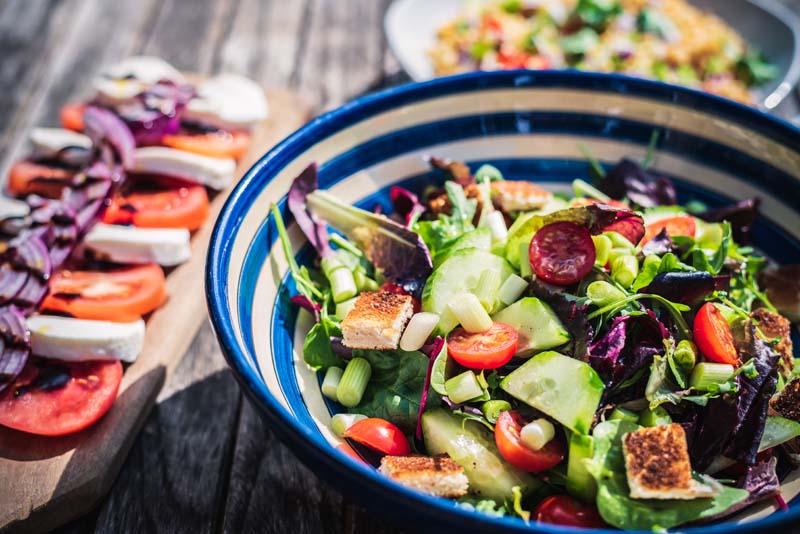
Diet & Nutrition
Diet and thinking about nutrition can be a huge benefit in treating symptoms. Eating plenty of vegetables, legumes, pulses, beans including soy products, nuts, seeds, dark berries, apples, whole grains especially oats, quinoa and buckwheat support hormonal balance.
Flax seeds / linseeds offer prebiotic soluble fibre, but they need to be ground to be digested and absorbed. They help modulate oestrogen and contain phytoestrogen lignans. Green leafy vegetables contain iron, B12, beta-carotene, vitamin C, potassium, calcium, and phytonutrients that all support hormone and mood balance as well as bone health. Examples of these include kale, chard, spinach, rocket, watercress, bok choy, leafy tops of carrots and beetroot. Brassicas contain calcium which is essential for women of all ages to ensure bone health. These include broccoli, cauliflower, brussel sprouts, cabbage, kale, swedes, turnips, asparagus, radishes, bok choy and watercress. Foods like extra virgin oil, seafood, nuts, seeds and avocado all have anti-inflammatory properties.
To ensure gut health include prebiotics as they feed the beneficial gut microbiome and as a result allow the body to absorb nutrients from foods effectively. Prebiotic foods include leeks, garlic, onions, cabbage, asparagus, beetroot, fennel, artichokes, dark berries, apples, cocoa, parsley, ginger and other fresh/dry herbs and spices. Prebiotics/Probiotics can help strengthen the gut/brain connection and support symptoms like brain fog.
Fermented foods can really help with digestion and supporting gut health too – yoghurt, kefir, sauerkraut, miso, kimchi, apple cider vinegar (look for bottles that contain the ‘mother’), natto, tempeh, kombucha and kavas. It is easy to make your own sauerkraut and there are many different variations. You can find an array of videos on YouTube plus it’s cheap to make.
Nuts and seeds offer a wealth of support giving the body inflammatory oils, minerals and protein. Sesame and pumpkin seeds are a great source of calcium which promote bone strength, muscle relaxation/contraction and moods. 700mg of calcium a day is what the NHS recommends. You can check your calcium levels using this Calcium Calculator.
Pulses, legumes and beans are great for increasing fibre in your diet and they also contain phytoestrogens. These phytoestrogens are not as strong as the oestrogen a woman produces herself, however they are beneficial. They ‘lock’ onto oestrogen receptors either protecting the body from the negative effects of too much oestrogen or supporting when oestrogen levels are low. This is particularly helpful during perimenopause when oestrogen levels are fluctuating. Soybeans / edamame beans contain isoflavones (phytoestrogens). Research has shown that isoflavones reduce hot flushes. If possible, always choose organic soybeans as the herbicide of choice in farming them, glyphosate, is known as a hormone disruptor. Cannellini beans are the most beneficial beans due to their high levels of calcium. They too contain phytoestrogens.
Sugar, refined carbohydrates, alcohol and caffeine all have a negative effect during perimenopause and menopause. All can exacerbate symptoms, particularly hot flushes. As our oestrogen levels fluctuate, we often crave sugar as our energy levels feel depleted and many women find weight gain around the abdomen begins to increase. Estrone is a weaker type of oestrogen that can be taken from this fat tissue, also known as visceral fat. However, I like to follow the 80/20 rule…..80% of the time eating to support my perimenopause symptoms and 20% of the time enjoying a delicious glass of wine, bar of chocolate or coffee! Hops have been shown to have a beneficial effect on sleep, restlessness, anxiety, nervousness, and irritability. So, maybe you choose to have a beer occasionally! Gluten free options are now widely available for coeliac and those with a gluten intolerance.
As oestrogen acts as a lubricant in the body it’s important to think about hydration as oestrogen fluctuates. During perimenopause and menopause you may notice that your skin and hair becomes drier. Aim to have 8 glasses of water each day on top of herbal teas. It can help to add a slice of cucumber, lemon, or your favourite fruit to a glass of water or water bottle, to add some flavour.
Cold Water
Cold showers or cold-water swimming have been shown to help alleviate depression, low mood and hot flushes and many women find Cognitive Behavioural Therapy (CBT), acupuncture and herbal remedies helpful.
Medication
Hormone Replacement Therapy is the answer for others, and this is something to be discussed with your doctor. There are many different options, and it can take 3-6 months to tweak the dose to get it just right. (Have a look at Davina McCall: Sex, Myths and the Menopause)
Whilst some women struggle with a plethora of symptoms many other women sail through this transition. It can a time for reflection, inspiration, and personal growth. Finding what helps you at this time in your life is crucial to making it a positive experience, as you transition into what the Japanese call the second spring. Word is beginning to travel and conversations are being had, we’re finally waking up to the menopause and we hope for the next generation the taboo of menopause will be a distant memory.



Thank you for your sharing. I am worried that I lack creative ideas. It is your article that makes me full of hope. Thank you. But, I have a question, can you help me?